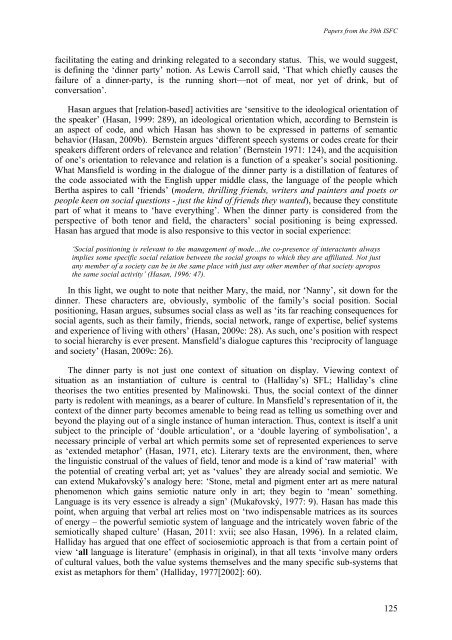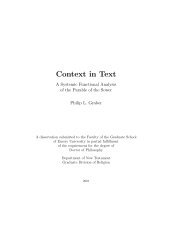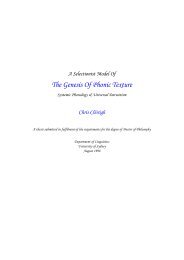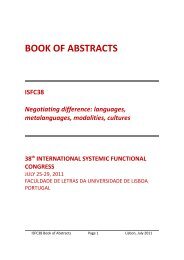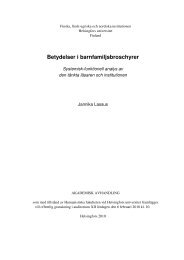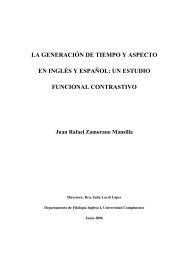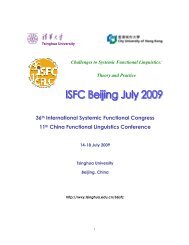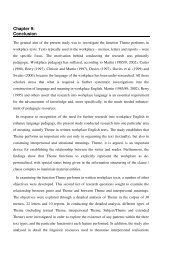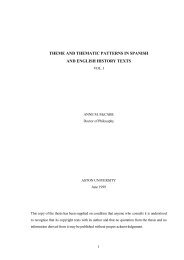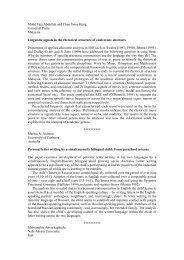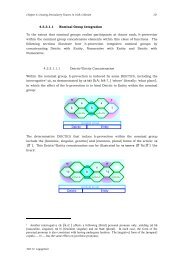the ISFC39 Proceedings - International Systemic-Functional ...
the ISFC39 Proceedings - International Systemic-Functional ...
the ISFC39 Proceedings - International Systemic-Functional ...
You also want an ePaper? Increase the reach of your titles
YUMPU automatically turns print PDFs into web optimized ePapers that Google loves.
Papers from <strong>the</strong> 39th ISFCfacilitating <strong>the</strong> eating and drinking relegated to a secondary status. This, we would suggest,is defining <strong>the</strong> ‘dinner party’ notion. As Lewis Carroll said, ‘That which chiefly causes <strong>the</strong>failure of a dinner-party, is <strong>the</strong> running short—not of meat, nor yet of drink, but ofconversation’.Hasan argues that [relation-based] activities are ‘sensitive to <strong>the</strong> ideological orientation of<strong>the</strong> speaker’ (Hasan, 1999: 289), an ideological orientation which, according to Bernstein isan aspect of code, and which Hasan has shown to be expressed in patterns of semanticbehavior (Hasan, 2009b). Bernstein argues ‘different speech systems or codes create for <strong>the</strong>irspeakers different orders of relevance and relation’ (Bernstein 1971: 124), and <strong>the</strong> acquisitionof one’s orientation to relevance and relation is a function of a speaker’s social positioning.What Mansfield is wording in <strong>the</strong> dialogue of <strong>the</strong> dinner party is a distillation of features of<strong>the</strong> code associated with <strong>the</strong> English upper middle class, <strong>the</strong> language of <strong>the</strong> people whichBertha aspires to call ‘friends’ (modern, thrilling friends, writers and painters and poets orpeople keen on social questions - just <strong>the</strong> kind of friends <strong>the</strong>y wanted), because <strong>the</strong>y constitutepart of what it means to ‘have everything’. When <strong>the</strong> dinner party is considered from <strong>the</strong>perspective of both tenor and field, <strong>the</strong> characters’ social positioning is being expressed.Hasan has argued that mode is also responsive to this vector in social experience:‘Social positioning is relevant to <strong>the</strong> management of mode…<strong>the</strong> co-presence of interactants alwaysimplies some specific social relation between <strong>the</strong> social groups to which <strong>the</strong>y are affiliated. Not justany member of a society can be in <strong>the</strong> same place with just any o<strong>the</strong>r member of that society apropos<strong>the</strong> same social activity’ (Hasan, 1996: 47).In this light, we ought to note that nei<strong>the</strong>r Mary, <strong>the</strong> maid, nor ‘Nanny’, sit down for <strong>the</strong>dinner. These characters are, obviously, symbolic of <strong>the</strong> family’s social position. Socialpositioning, Hasan argues, subsumes social class as well as ‘its far reaching consequences forsocial agents, such as <strong>the</strong>ir family, friends, social network, range of expertise, belief systemsand experience of living with o<strong>the</strong>rs’ (Hasan, 2009c: 28). As such, one’s position with respectto social hierarchy is ever present. Mansfield’s dialogue captures this ‘reciprocity of languageand society’ (Hasan, 2009c: 26).The dinner party is not just one context of situation on display. Viewing context ofsituation as an instantiation of culture is central to (Halliday’s) SFL; Halliday’s cline<strong>the</strong>orises <strong>the</strong> two entities presented by Malinowski. Thus, <strong>the</strong> social context of <strong>the</strong> dinnerparty is redolent with meanings, as a bearer of culture. In Mansfield’s representation of it, <strong>the</strong>context of <strong>the</strong> dinner party becomes amenable to being read as telling us something over andbeyond <strong>the</strong> playing out of a single instance of human interaction. Thus, context is itself a unitsubject to <strong>the</strong> principle of ‘double articulation’, or a ‘double layering of symbolisation’, anecessary principle of verbal art which permits some set of represented experiences to serveas ‘extended metaphor’ (Hasan, 1971, etc). Literary texts are <strong>the</strong> environment, <strong>the</strong>n, where<strong>the</strong> linguistic construal of <strong>the</strong> values of field, tenor and mode is a kind of ‘raw material’ with<strong>the</strong> potential of creating verbal art; yet as ‘values’ <strong>the</strong>y are already social and semiotic. Wecan extend Mukařovský’s analogy here: ‘Stone, metal and pigment enter art as mere naturalphenomenon which gains semiotic nature only in art; <strong>the</strong>y begin to ‘mean’ something.Language is its very essence is already a sign’ (Mukařovský, 1977: 9). Hasan has made thispoint, when arguing that verbal art relies most on ‘two indispensable matrices as its sourcesof energy – <strong>the</strong> powerful semiotic system of language and <strong>the</strong> intricately woven fabric of <strong>the</strong>semiotically shaped culture’ (Hasan, 2011: xvii; see also Hasan, 1996). In a related claim,Halliday has argued that one effect of sociosemiotic approach is that from a certain point ofview ‘all language is literature’ (emphasis in original), in that all texts ‘involve many ordersof cultural values, both <strong>the</strong> value systems <strong>the</strong>mselves and <strong>the</strong> many specific sub-systems thatexist as metaphors for <strong>the</strong>m’ (Halliday, 1977[2002]: 60).125


